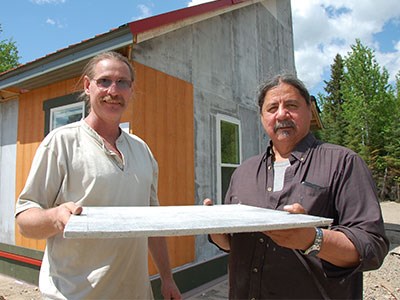Aboriginal home builder Bernie Bird is counting on a fat order book this summer to start the cash flowing toward erecting a composite home manufacturing factory in Dryden.
His company, AlterNative Homes, is aiming to break ground on a panel plant in the city’s industrial park by late summer and be in operation by mid-winter or spring of 2015.
In early June, the Edmonton-based Bird and vice-president Leon Tirums were building a 15- by 36-foot demonstration home at Eagle Lake First Nation in preparation for an early July showing for an invited guest list of 20 First Nation chiefs from across northwestern Ontario, Manitoba, Saskatchewan and Alberta.
The company hopes to build off of a successful showing of their building system at the Assembly of First Nations annual conference in Toronto.
“Everybody’s waiting for the call to come and see this,” said Tirums.
The company is also waiting on $2.35 million in provincial funding for the new building and the machinery.
“We’re in the middle of the funding stages and once we do have a (home) showing, we’ll probably come out of there with a couple of contracts,” said Bird. “We have lenders that want us to have contracts before they lend us the money.”
Before getting into home building, Bird, a Moose Cree, grew up in northeastern and southern Ontario then headed to Alberta to work as a petroleum engineer.
The company is gearing its product toward Aboriginal clients, especially in communities plagued by the substandard housing issues that can arise from conventional stick-built homes.
Their building product is founded around the production of a magnesium oxide board which is mould- and mildew-resistant and fire retardant.
The Dryden plant layout and technology used is being kept under wraps, but it will feature a line of pultrusion machines, a process used in manufacturing composite materials to make walls, roof and floor panels.
The company is also touting the durability of their panel homes.
“In standard housing, you may have plywood on the outside with a single shear wall,” said Tirums, a Montana builder who’s worked in the industry along the U.S. Gulf Coast. “Ours are strong with double shear walls. It’s twice as strong as it’s not going anywhere.
“I’ve been a contractor for 30 years and there’s nothing like this.”
Tirums claims once these homes are assembled and sealed, they’re practically “hurricane-proof.”
For a basic unfinished home, the cost per square foot ranges between $80 and $110, and can be custom designed to any configuration.
“We have a few models worked out,” said Bird. “We’ve been asking communities what size they like. We have three models with one just under 900 square feet, one over 1,000, and one over 1,200.”
When operating, the Dryden plant should produce enough panel material for three to four homes a day. The panels can be delivered to a construction site within two weeks from the time an order is taken and assembled within days.
The product has wide-ranging building applications such as docks and highway sound barriers.
“Everything’s open but our main focus is the Native community,” said Tirums.
The company will have an assembly team, but there will be spinoff opportunities for local electricians, plumbers and other trades.
Special emphasis is being placed on providing First Nation employment opportunities and skill development.
Training will be done on the assembly site, but the company also wants to erect facility to show the step-by-step process.
Tirums hopes a panel plant will lure some Aboriginal people back home.
“Many leave the communities because there’s no work, and they all need a lot of houses. There would be years of work just on their own reserves. They now have a trade and can live at home.”
Depending on future demand, building regional satellite factories is a distinct possibility.
Tirums said several First Nation communities already have come forward and offered buildings for their own production plants.
“The interest is there, it’s just a matter of getting it going, but we need the factory going ideally in order to make that happen.”




